If you are looking for a low-maintenance plant to grace your home or office, look no further than Lucky Bamboo! This iconic plant is easy to care for and propagate, making it a great choice for any green thumb. In this article, we will cover the basics of Lucky Bamboo care, from watering and light requirements to fertilization and pest control. We’ll also discuss how to propagate Lucky Bamboo so you can enjoy this popular plant yourself!
Lucky Bamboo Characteristics
Lucky Bamboo is not actually bamboo, but a member of the Dracaena family. This tropical plant is native to Africa and Asia, where it grows in swampy conditions. Lucky Bamboo can reach up to six feet in height, but most plants sold are much smaller. The stalks of Lucky Bamboo are often braided or twisted into shapes for aesthetic appeal. The leaves are long and narrow, ranging in color from deep green to yellow-green.
Lucky Bamboo is a very popular plant due to its low maintenance requirements. It is tolerant of a wide range of growing conditions and can even be grown hydroponically! This makes Lucky Bamboo an ideal choice for those who do not have a lot of experience with plants. [3]
Types of Lucky Bamboo
There are three types of lucky bamboo – Dracaena sanderiana,Dracaena braunii, and Dracaena sambucina. The most common type is Dracaena sanderiana, which is also known as ribbon bamboo or Chinese water bamboo.
The third type of lucky bamboo is Dracaena sambucina, which is also called songzhong lucky bamboo or umbrella luck bamboo. This type of lucky bamboo has a cluster of stalks that resemble an umbrella. [3]

Propagating Lucky Bamboo
Selecting a Healthy Stalk
The first step to propagating your own lucky bamboo is to select a healthy stalk from the plant. This stalk should have at least two nodes, or sets of leaves. f the stalk you select is too short, it may not survive the propagation process.
Once you’ve selected a healthy stalk, use a sharp knife or pair of scissors to cut it just below a node. Make sure that the cut you make is clean so that the new plant can easily develop roots.
Now, fill a container with clean water and place your cutting in it. You’ll want to use a container that’s deep enough for the entire cutting to be submerged in water. It’s important to use clean water because it will help prevent the development of bacteria that could harm your new plant.
Within a few weeks, you should see roots beginning to develop on your cutting. Once these roots are about an inch long, you can transplant your new plant into a pot filled with fresh soil. [1]
Removing the Offshoot
Offshoots are side shoots that grow from the main stalk of your lucky bamboo plant. Although they may look unsightly, you should not remove them unless they are causing problems for the rest of the plant. If an offshoot is growing in an undesirable direction, you can trim it back using sharp scissors or a knife.
t’s best to wait until the offshoot is at least six inches long before you attempt to remove it. This will give you enough material to work with and will minimize the risk of damaging the main stalk.
To remove an offshoot, first cut it away from the main stalk at a 45-degree angle. Next, use a sharp knife to make a shallow cut around the base of the offshoot. Finally, carefully twist the offshoot until it comes free from the stalk.
f you’re having difficulty removing an offshoot, you can try soaking the plant in a solution of warm water and vinegar for 30 minutes. This will help to loosen the soil and make it easier to remove the offshoot.
Once you’ve removed the offshoot, you can either discard it or pot it up in fresh soil. If you choose to pot it up, make sure that you give it plenty of light and water it regularly. With a little care, your offshoot will soon grow into a healthy plant! [1]
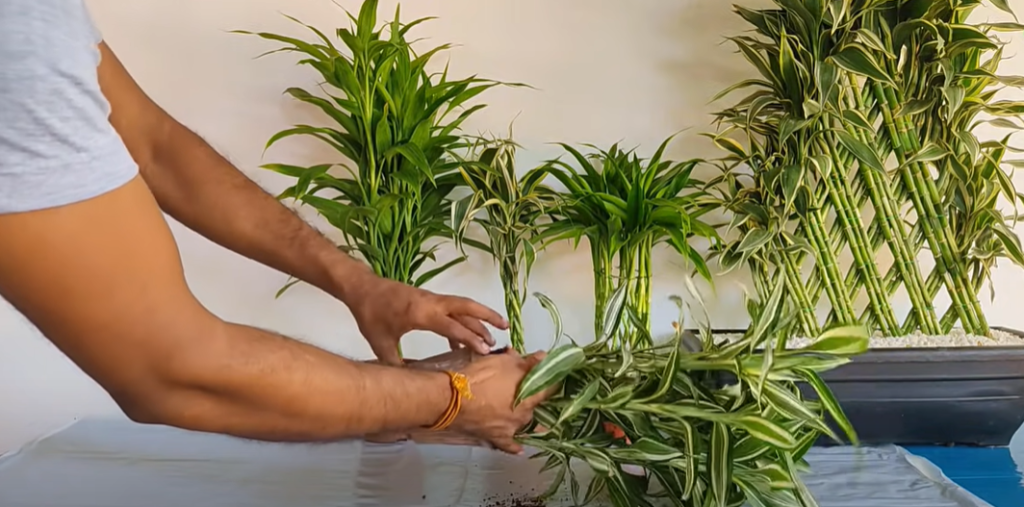
Trimming Bottom Leaves From the Offshoot
f your bamboo has become too tall, you can cut off the top leaves to encourage it to grow wider. You can also trim bottom leaves from the offshoot to keep it a manageable size. If you want your bamboo to grow taller, cut off the lower leaves so that more energy goes into growing new shoots.
To propagate lucky bamboo, simply cut a stalk at an angle and place it in water. Change the water every week, and in a few weeks, you should see roots growing. Once the roots are about an inch long, you can transplant them into soil. Be sure to keep the soil moist but not soggy. [1]
Deciding How to Root the Cutting
Rooting in water
The most common way to propagate lucky bamboo is by rooting the cuttings in water. To do this, you’ll need a clean, sharp knife or pair of scissors and a container for the cutting. Fill the container with fresh water and place the cutting in it so that at least an inch (two centimeters) of the stem is submerged.
Change the water every few days to keep it fresh, and be sure to use distilled or purified water if your tap water is high in minerals.
You should see roots start to grow within a few weeks, and once they’re about an inch (two centimeters) long, you can transplant the cutting into soil. [1]
Rooting in soil
f you’re growing your lucky bamboo in soil, the process is a bit different. You’ll need to start by adding some rocks to the bottom of a vase or pot. This will help with drainage so that your roots don’t rot. Then, add a layer of potting soil on top of the rocks and place your plant in the pot. Water regularly, making sure that the soil stays moist but not soggy.
To propagate, or create new plants from cuttings, take a sharp knife and cut off about two inches from the stem of an existing plant. Place the cutting in water and wait for it to form roots. Once it has rooted, you can then transplant it into soil.
To propagate, or create new plants from cuttings, take a sharp knife and cut off about two inches from the stem of an existing plant. Place the cutting in water and wait for it to form roots. Once it has rooted, you can then transplant it into soil. [1]

How Long Does it Take Lucky Bamboo to Propagate?
Lucky bamboo is a fast grower, and it can take as little as two weeks for new roots to form. However, it’s best to give your plants some time to adjust to their new environment before you start propagating them. I like to wait at least four weeks before I start propagating my lucky bamboo. [1]
To propagate your lucky bamboo, you’ll need a sharp knife or pair of scissors, a clean container filled with fresh water, and some patience!
Caring for the Cut Parent Stalk
f you’re lucky enough to have a parent stalk of your own, there are a few things you should know in order to keep it healthy. First and foremost, cut stalks should be kept in water at all times. The water should be changed every three to five days, and the stalk should be trimmed every two weeks or so. [1]
t’s also important to make sure that the water is clean and free of chlorine. You can do this by using distilled water or letting tap water sit out for 24 hours before use.
Care After Propagating
Light & Position
Lucky bamboo does best in bright, indirect sunlight. If you don’t have a spot that gets bright, indirect light, you can grow lucky bamboo under fluorescent lights.
You’ll need to position the fluorescent tube about six inches above the plants and leave it on for about 12 hours per day. [1]
Watering
Lucky bamboo does not like to sit in water, so it’s important to make sure the container you’ve placed it in has good drainage. The best way to water your lucky bamboo is to use a spray bottle and mist the plant every few days. You can also dunk the entire plant in a bowl of water for a minute or two before letting it drain thoroughly.
f you notice the leaves of your lucky bamboo turning yellow, that’s a sign that it’s getting too much direct sunlight or that the roots are sitting in water for too long. Move your plant to a location with indirect light and make sure you’re not over-watering it. [1]
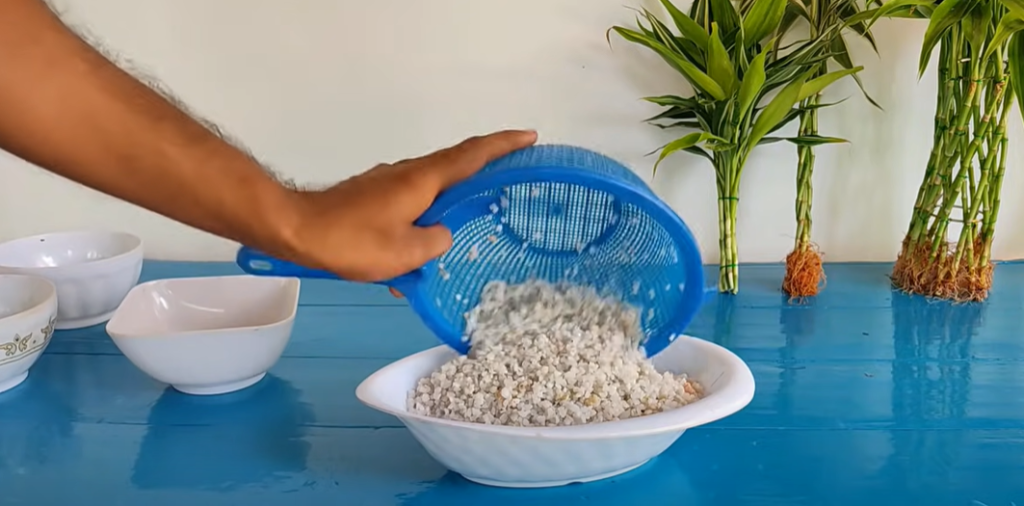
Fertilizing
Fertilizing is an important part of taking care of your lucky bamboo. You can use any type of liquid fertilizer, but make sure it is diluted to half the recommended strength. Fertilize every other week during the growing season and monthly during the winter.
To fertilize, simply remove the lucky bamboo from its pot and place it in a bowl of water mixed with fertilizer. Leave it soak for about 30 minutes, then drain off any excess water and return the plant to its pot. [1]
Temperature and Humidity
Lucky bamboo does best in a warm climate. The ideal temperature range is between 70 and 90 degrees Fahrenheit. If the temperature gets too hot or too cold, the leaves will start to turn yellow.
Humidity is also important for lucky bamboo. They like it to be around 50-60%. You can increase the humidity around your plant by misting it with water or using a humidifier.
f you live in an area with very low humidity, you can try growing your lucky bamboo in a terrarium. This will help create a more humid environment for your plant.
Just make sure that the terrarium has good ventilation so that the air doesn’t get too stagnant. [1]
Container Size
The size of the pot or container you choose for your bamboo will depend on how many stalks you want to grow. A general rule of thumb is to use a pot that is two inches wider than the diameter of the bamboo stalk.
For soil, you can use any type of potting mix as long as it is well-draining. Lucky bamboo does not like to sit in water, so make sure that the pot has drainage holes. You can also add some gravel to the bottom of the pot to help with drainage. [1]
When to Transfer to Soil
Lucky Bamboo can grow in soil, but it’s often grown in water. If you decide to transfer your plant to soil, do so in the spring. Use a well-draining potting mix and place the pot in an area with bright, indirect light. Allow the soil to dry out between waterings. [1]
Common Growing Problems
Lucky bamboo is a hardy plant, but it can still experience some common problems. Overwatering is the most common issue, as too much water can lead to root rot. If you notice your lucky bamboo turning yellow or brown, it’s likely a sign of overwatering. Allow the soil to dry out completely between watering to avoid this problem.
Yellow or brown leaves can also be caused by too much direct sunlight. Lucky bamboo prefers bright, indirect light, so if you notice the leaves starting to fade, move it to a shadier spot. [2]
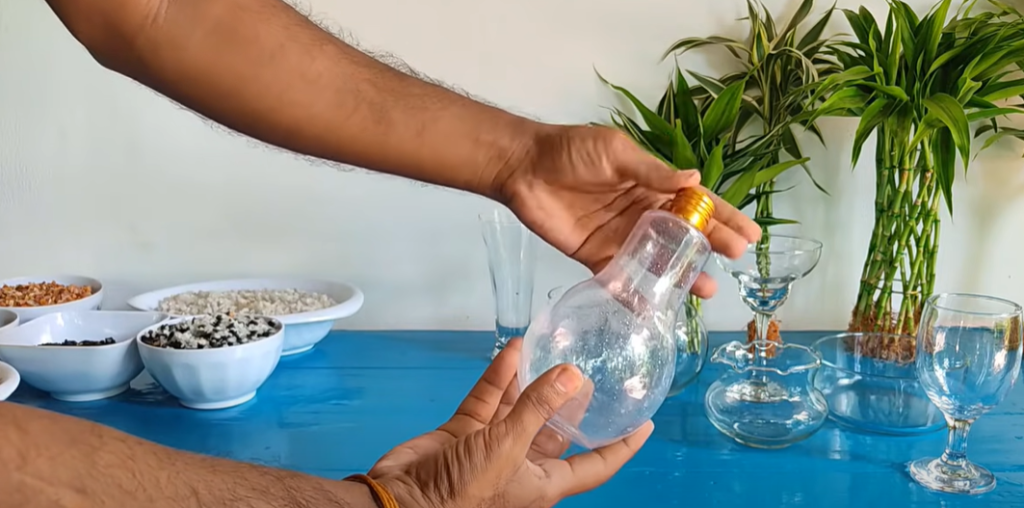
Potting and Repotting
Lucky bamboo can grow in either soil or water, but most people choose to pot it in soil for aesthetic reasons. When repotting, be sure to use a well-draining potting mix and a pot with drainage holes. f you’re growing lucky bamboo in water, change the water every week or so and rinse the roots thoroughly to remove any build-up of minerals.
f you notice your lucky bamboo starting to yellow or lose its color, it’s probably due to a lack of nutrients. To remedy this, fertilize your plant once a month using a balanced fertilizer meant for houseplants. Be sure to follow the directions on the package carefully so you don’t over-fertilize and damage your plant. [2]
Pruning/Trimming
Lucky bamboo can be pruned or trimmed to maintain its shape or to encourage new growth. When pruning, it’s important to use sharp, clean shears or scissors. This will prevent the plant from being damaged and will help ensure a clean cut.
To encourage new growth, trim off the tips of the stems. This will stimulate the plant to produce new leaves and branches. Trimming also allows you to control the shape of your lucky bamboo plant.
Pruning is also necessary if your plant becomes overgrown. When trimming back an overgrown plant, be sure to remove any yellow or brown leaves. These are signs that the plant is unhealthy and needs to be trimmed back. [4]
What Not To Do With Your Lucky Bamboo
Lucky bamboo is a popular plant, but it’s also one that people often don’t know how to care for properly. As a result, they end up making some common mistakes that can damage or even kill their plants. Here are some of the most common mistakes people make with their lucky bamboo, and what you should do instead:
- Don’t put lucky bamboo in direct sunlight. The leaves will scorch and the plant will eventually die. Instead, place it in a spot where it will get indirect light.
- Don’t overwater lucky bamboo. The roots will rot and the plant will die. Water only when the soil is dry to the touch.
- Don’t use regular potting soil for lucky bamboo. Instead, use a special lucky bamboo potting mix or make your own by mixing equal parts sand and peat moss.
- Don’t fertilize lucky bamboo too often. Too much fertilizer will burn the roots and leaves. Fertilize once a month at most, using a water-soluble fertilizer diluted to half strength. [4]
Safety Considerations
f you have small children or pets, you’ll want to take some safety precautions with your lucky bamboo. All parts of the plant are poisonous if ingested, so it’s important to keep it out of reach of little ones and furry friends.
Finally, although lucky bamboo isn’t known to be particularly harmful to pets, there have been a few reports of dogs and cats becoming ill after eating the leaves. If you’re concerned about your pet’s safety, it’s best to keep this plant out of reach. [3]
FAQ
Is lucky bamboo easy to propagate?
Yes, lucky bamboo is very easy to propagate. All you need is a sharp knife and a clean pot with fresh soil. To propagate, simply cut the stalk at an angle about an inch below where you want the new plant to grow. Place the cutting in the pot and water regularly. In a few weeks, you should see new growth!

Can you grow more lucky bamboo from cuttings?
Yes, you can grow more lucky bamboo from cuttings! To do this, firstly take a cutting from an existing plant that is at least six inches tall. Cut the stalk at an angle just below a leaf node using a sharp knife or pruning shears. Next, remove any leaves from the bottom half of the cutting. Finally, place the cutting in a jar or glass of water and wait for it to root. Keep the water clean and fresh, and within a few weeks, you should see new roots growing!
Does bamboo do better in water or soil?
Lucky bamboo can actually be grown in either water or soil, although it is more commonly seen in water. If you choose to grow your lucky bamboo in water, be sure to change the water every week and use only distilled or spring water. Soil-grown lucky bamboo will need to be watered about once a week, and the soil should be kept moist but not soggy. Either way, keep an eye on your plant and adjust its watering schedule as needed.
What is the best fertilizer for lucky bamboo?
There are a few different types of fertilizer that you can use on your lucky bamboo, but we recommend using a balanced liquid fertilizer that is specifically made for green plants. You can apply the fertilizer every other week during the growing season, and once a month during the winter.
To fertilize your lucky bamboo, simply mix the recommended amount of fertilizer with water according to the package instructions. Then, use a spray bottle or watering can to evenly mist the leaves and stems of your plant. Be sure to avoid getting any fertilizer on the roots, as this can burn them.
Does bamboo need soil or rocks?
Lucky bamboo doesn’t need soil or rocks. You can grow it in water with just a few rocks to keep it in place.
f you want to use soil, choose a light potting mix and make sure the pot has drainage holes. Water the bamboo when the top inch of soil is dry. Don’t let the plant sit in water, as this can cause root rot. Fertilize monthly with a balanced houseplant fertilizer diluted by half.
Useful Video: Lucky Bamboo Care and Propagation for Beginners
Conclusion
Lucky bamboo is a great plant for both novice and experienced gardeners. With proper care, it can thrive indoors or outdoors. Propagating lucky bamboo is easy and only requires a few simple supplies.
We hope you enjoyed this article and found it helpful. If you have any questions or comments, please feel free to leave them below! Thanks for reading!
References:
- https://houseplantresourcecenter.com/2022/05/how-to-propagate-lucky-bamboo-care-guide/?utm_source=rss&utm_medium=rss&utm_campaign=how-to-propagate-lucky-bamboo-care-guide
- https://www.mydomaine.com/bamboo-plant-care-4772870#toc-potting-and-repotting-lucky-bamboo
- https://www.bobvila.com/articles/lucky-bamboo-care/
- https://www.joyusgarden.com/lucky-bamboo-care-tips/




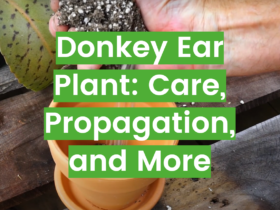
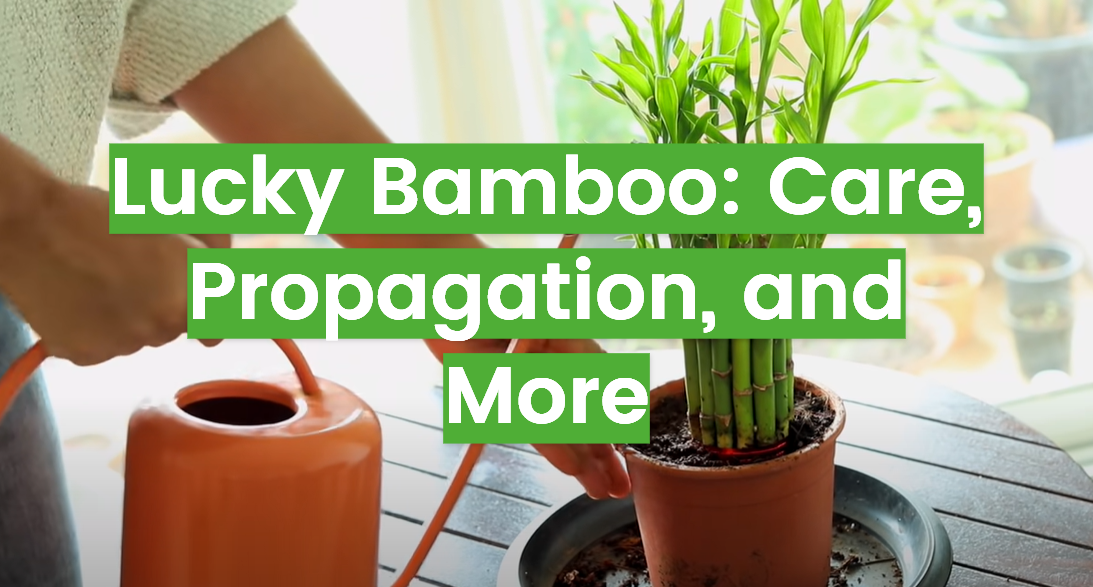




Leave a Review